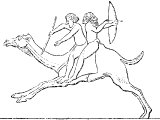The earliest mention of horses and Bedouins
… occurs in the archives of Dur-Sharrukin (today’s Khorsabad), the capital of Assyrian King Sargon II (721-705 BC). It dates from around 715 BC. It mentions king Sargon II exacting tribute from “Pir’u king of Musuri, Shamsi queen of the Arabs (a-rib-bi in the original text), Itamra king of Saba, the kings of the coast and the desert I received gold, products (?) from the mountain, precious stones, ivory, all kinds of perfumes, horses, and camels as their tribute.”
The same tablet mentions “the distant Arabs, dwellers of the desert, who did not know learned men or scribes, who had not brought tribute to any king”. In other words, these Arabs are the Bedouins.
Horses? Yes! Horses as tribute from the Queen of the Bedouins to the allmighty Assyrian king! (There is some speculation as to whether “Pir’u king of Musuri” is one of the Pharaohs of Egypt). Of course, a large number of earlier ancient Middle Eastern sources mentions horses, but this one is the earliest one where the mention of horses is paired with a mention of the ” dwellers of the desert”.
Perhaps the coolest thing is that these Arab Bedouins were ruled by a woman. I am going to call my next filly Shamsi.
[Update: Nov. 16: check the reference in Encyclopedia Britannica, here]

Thanks for this, Edouard. I have often wondered if it was possible to find an actual historical date first linking the bedouin with horses and it looks like you’ve done it. “Pir’u king of Musuri” is close to both the Arabic and Hebrew “Pharoah of Egypt – in both ancient and modern Hebrew Egypt is known as Mitsraiyim.
From my understanding the Bedu used camels for from a much earlier period – does anyone have a date on that?
I also like the fact that these Arab Bedouin were ruled by a woman and may borrow the name myself.
I wonder (to borrow this phrase again) if Shamsi, Queen of the Arabs, is a reason for why ancestry is traced through the female line of the pedigree. In all that I have read recently, concerning the worship in long ago times of the divine feminine, it makes sense for an ancient breed of horse which will emphasize the female side of the pedigree. Does it all comes together with this revelation of Shamsi. You really got me today, Edouard! Nice job and very thought provoking. I am not going to be thinking of much else today: Asil, Saudi and Shamsi. Hmmmmm…..
Hi Tzviah, on camels and Bedouins, check out Richard Bulliet’s “the Camel and the Wheel” which is the reference on the subject.
Ralph, Shamsi’s daughter Zabibah was Queen of the Arabs too.. and also fought the Assyrians..